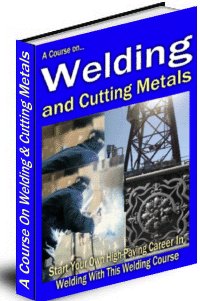
Only $9.99 |
Start Your
Own High-Paying Career In
Welding With This Welding Course
At last you can now start to
learn welding - the art of joining and cutting metals with The
Welding Course - right at the comfort of your home in your free
time! |
A
Career In Welding and Cutting Metals
Dear friend,
Would you like
to start a potentially lucrative career or business with a welding
skill?
Acquiring a new
skill in welding could give you a potentially high-paying career (Salary Range: $13.00-$26.44 per hour).
It could also
open for you a floodgate of new opportunities with various
businesses and arts and crafts that you have only dreamt about of starting
and enjoying.
At last you can
now start to learn welding - the art of joining and cutting metals with The Welding Course - right at the comfort of your home in your free time.
The Welding
Course is the textbook equivalent of a hands-on welding training.
It prepares and orients you to the basic as well the advanced.
It contains all necessary information and data
in one volume, making it possible for the workman to use one source for securing a
knowledge of both principle and practice, preparation and finishing of the
work, and both large and small repair work as well as manufacturing methods
used in metal working.
With almost a
hundred illustrations, the 50,084-word Welding Course will guide you step-by-step towards learning the art and craft of joining and cutting metals.
It is a complete
course in itself that will show you comprehensive knowledge on the
following:
 METALS AND ALLOYS--HEAT TREATMENT:--The Use and Characteristics of the Industrial Alloys and Metal Elements--Annealing, Hardening, Tempering and
METALS AND ALLOYS--HEAT TREATMENT:--The Use and Characteristics of the Industrial Alloys and Metal Elements--Annealing, Hardening, Tempering and
Case Hardening of Steel
 WELDING MATERIALS:--Production, Handling and Use of the Gases, Oxygen and
Acetylene--Welding Rods--Fluxes--Supplies and Fixtures WELDING MATERIALS:--Production, Handling and Use of the Gases, Oxygen and
Acetylene--Welding Rods--Fluxes--Supplies and Fixtures
 ACETYLENE GENERATORS:--Generator Requirements and
Types--Construction--Care and Operation of Generators. ACETYLENE GENERATORS:--Generator Requirements and
Types--Construction--Care and Operation of Generators.
 WELDING INSTRUMENTS:--Tank and Regulating Valves and Gauges--High, Low and
Medium Pressure Torches--Cutting Torches--Acetylene-Air Torches WELDING INSTRUMENTS:--Tank and Regulating Valves and Gauges--High, Low and
Medium Pressure Torches--Cutting Torches--Acetylene-Air Torches
 OXY-ACETYLENE WELDING PRACTICE:--Preparation of Work--Torch Practice--Control of the Flame--Welding Various Metals and Alloys--Tables of OXY-ACETYLENE WELDING PRACTICE:--Preparation of Work--Torch Practice--Control of the Flame--Welding Various Metals and Alloys--Tables of
Information Required in Welding Operations
 ELECTRIC WELDING:--Resistance Method--Butt, Spot and Lap
Welding--Troubles and Remedies--Electric Arc Welding ELECTRIC WELDING:--Resistance Method--Butt, Spot and Lap
Welding--Troubles and Remedies--Electric Arc Welding
 HAND FORGING AND WELDING:--Blacksmithing, Forging and Bending--Forge HAND FORGING AND WELDING:--Blacksmithing, Forging and Bending--Forge
Welding Methods
 SOLDERING, BRAZING AND
THERMAL WELDING:--Soldering Materials and Practice--Brazing--Thermal Welding SOLDERING, BRAZING AND
THERMAL WELDING:--Soldering Materials and Practice--Brazing--Thermal Welding
 OXYGEN PROCESS FOR REMOVAL OF CARBON OXYGEN PROCESS FOR REMOVAL OF CARBON
Only $9.99
Think
about finding a new, high-paying career that you enjoy...and how about
creating new things from your garage out of junk like:
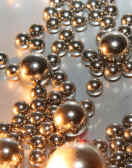
Metal Sculptures
and other arts and crafts |
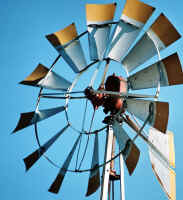
Useful things
that will make or save you money |
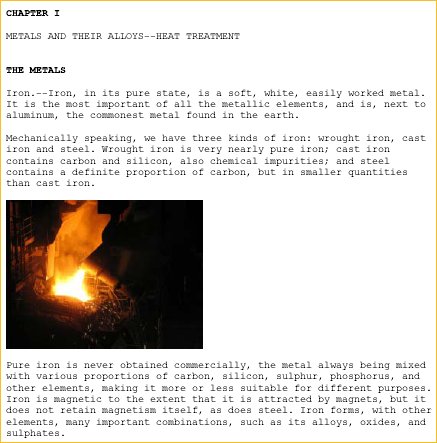
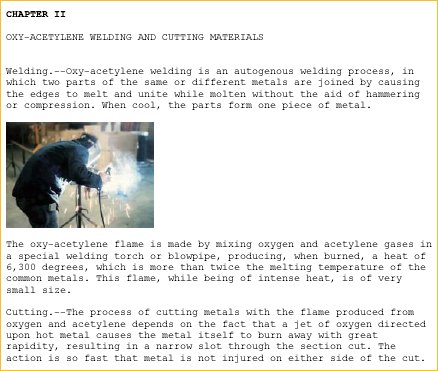
OXY-ACETYLENE WELDING PRACTICE
PREPARATION OF WORK
Preheating.--The practice of heating the metal around the weld
before applying the torch flame is a desirable one for two reasons. First,
it makes the whole process more economical; second, it avoids the danger of
breakage through expansion and contraction of the work as it is heated and
as it cools.
When it is desired to join two surfaces by welding them, it is, of course,
necessary to raise the metal from the temperature of the surrounding air to
its melting point, involving an increase in temperature of from one thousand to nearly three thousand degrees. To obtain this entire increase
of temperature with the torch flame is very wasteful of fuel and of the operator's time. The total amount of heat necessary to put into metal is
increased by the conductivity of that metal because the heat applied at the
weld is carried to other parts of the piece being handled until the whole
mass is considerably raised in temperature. To secure this widely
distributed increase the various methods of preheating are adopted.
As to the second reason for preliminary heating. It is understood that the
metal added to the joint is molten at the time it flows into place. All the
metals used in welding contract as they cool and occupy a much smaller space than when molten. If additional metal is run between two adjoining
surfaces which are parts of a surrounding body of cool metal, this added metal will cool while the surfaces themselves are held stationary in the
position they originally occupied. The inevitable result is that the metal
added will crack under the strain, or, if the weld is exceptionally strong,
the main body of the work will he broken by the force of contraction. To
overcome these difficulties is the second and most important reason for preheating and also for slow cooling following the completion of the weld.
There are many ways of securing this preheating. The work may be brought to
a red heat in the forge if it is cast iron or steel; it may he heated in special ovens built for the purpose; it may be placed in a bed of charcoal
while suitably supported; it may be heated by gas or gasoline preheating torches, and with very small work the outer flame of the welding torch
automatically provides means to this end.
The temperature of the parts heated should be gradually raised in all
cases, giving the entire mass of metal a chance to expand equally and to adjust itself to the strains imposed by the preheating. After the region
around the weld has been brought to a proper temperature the opening to be
filled is exposed so that the torch flame can reach it, while the remaining
surfaces are still protected from cold air currents and from cooling through natural radiation.
One of the commonest methods and one of the best for handling work of rather large size is to place the piece to be welded on a bed of fire brick
and build a loose wall around it with other fire brick placed in rows, one
on top of the other, with air spaces left between adjacent bricks in each row. The space between the brick retaining wall and the work is filled with
charcoal, which is lighted from below. The top opening of the temporary oven is then covered with asbestos and the fire kept up until the work has
been uniformly raised in temperature to the desired point.
When much work of the same general character and size is to be handled, a permanent oven may be constructed of fire brick, leaving a large opening
through the top and also through one side. Charcoal may be used in this form of oven as with the temporary arrangement, or the heat may be secured
from any form of burner or torch giving a large volume of flame. In any method employing flame to do the heating, the work itself must be protected
from the direct blast of the fire. Baffles of brick or metal should be
placed between the mouth of the torch and the nearest surface of the work so that the flame will be deflected to either side and around the piece
being heated.
The heat should be applied to bring the point of welding to the highest temperature desired and, except in the smallest work, the heat should
gradually shade off from this point to the other parts of the piece. In the
case of cast iron and steel the temperature at the point to be welded should be great enough to produce a dull red heat. This will make the whole
operation much easier, because there will be no surrounding cool metal to reduce the temperature of the molten material from the welding rod below
the point at which it will join the work. From this red heat the mass of
metal should grow cooler as the distance from the weld becomes greater, so
that no great strain is placed upon any one part. With work of a very irregular shape it is always best to heat the entire piece so that the
strains will be so evenly distributed that they can cause no distortion or
breakage under any conditions.
The melting point of the work which is being preheated should be kept in mind and care exercised not to approach it too closely. Special care is
necessary with aluminum in this respect, because of its low melting temperature and the sudden weakening and flowing without warning. Workmen
have carelessly overheated aluminum castings and, upon uncovering the piece
to make the weld, have been astonished to find that it had disappeared.
Six hundred degrees is about the safe limit for this metal. It is possible
to gauge the exact temperature of the work with a pyrometer, but when this
instrument cannot be procured, it might be well to secure a number of "temperature cones" from a chemical or laboratory supply house. These cones
are made from material that will soften at a certain heat and in form they
are long and pointed. Placed in position on the part being heated, the point may be watched, and when it bends over it is sure that the metal
itself has reached a temperature considerably in excess of the temperature
at which that particular cone was designed to soften.
The object in preheating the metal around the weld is to cause it to expand
sufficiently to open the crack a distance equal to the contraction when cooling from the melting point. In the case of a crack running from the
edge of a piece into the body or of a crack wholly within the body, it is usually satisfactory to heat the metal at each end of the opening. This
will cause the whole length of the crack to open sufficiently to receive the molten material from the rod. |
Subscribe
for A Free Sample!
We
are so sure of our product that we'd be willing to give you a free
sample excerpt just for subscribing. Try before you buy. If
you are not thoroughly convinced that this ebook is for you, don't
buy it, period.
We
keep our subscriber's privacy sacred. We do not sell or rent your
personal information to other parties.
What's more you can always
unsubscribe anytime!
|
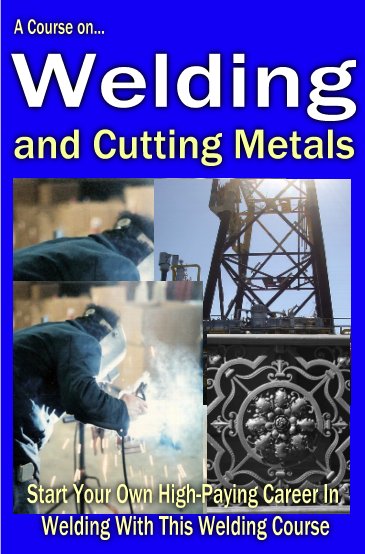
 |
Unequivocal 60-day
Money-back Guarantee
If for any reason you are not satisfied with this ebook, send
me an email for a full refund of your money! |
Only $9.99
Please
note. The ebook is in PDF. file format. You need an Adobe Acrobat
Reader to be able to read the ebook. If you do not have Adobe Acrobat
Reader installed in your computer, you can download it at http://www.adobe.com.
It's completely FREE.
|